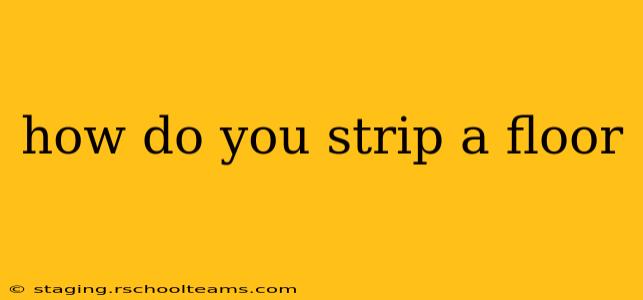Stripping a floor is a challenging but rewarding DIY project that can dramatically improve the look and feel of your home. Whether you're dealing with old varnish, paint, or adhesive, this comprehensive guide will walk you through the process, covering everything from preparation to finishing touches. This guide will help you tackle the job safely and effectively, no matter your experience level.
What are the Different Types of Floor Strippers?
Before diving into the process, let's explore the different types of floor strippers available:
-
Chemical Strippers: These are the most common type and come in various formulations depending on the type of finish you're removing (e.g., paint, varnish, polyurethane). They typically contain methylene chloride or other strong solvents. Always carefully read and follow the manufacturer's instructions, as they can be hazardous if misused. Proper ventilation is crucial.
-
Non-Chemical Strippers: These are often water-based and generally considered safer for the environment and the user. However, they tend to be less effective and require more scrubbing, potentially increasing the overall time investment.
-
Specialty Strippers: Some strippers are designed specifically for certain floor types (e.g., wood, concrete) or finishes (e.g., epoxy). Choosing the right stripper is critical for optimal results.
What Tools Do I Need to Strip a Floor?
Gathering the right tools is essential for a smooth stripping process. You'll need:
- Floor stripper: Choose the appropriate type based on your floor's finish.
- Scraper: A variety of scrapers—putty knives, floor scrapers, and even plastic scrapers—can be helpful for removing loosened finish.
- Stiff-bristled brush: A brush with stiff bristles will help agitate the stripper and loosen the finish.
- Clean cloths or rags: Lots of them! You'll need these for wiping up the stripper and the loosened finish.
- Safety equipment: This is crucial. Wear gloves, eye protection, and a respirator, especially when using chemical strippers. Ventilation is also essential.
- Buckets: At least two; one for the stripper and one for rinsing cloths.
- Neutralizer (if required): Some strippers require a neutralizer to deactivate the chemicals after stripping. Check the manufacturer's instructions.
- Floor sander (optional): For achieving a perfectly smooth finish after stripping.
How Long Does It Take to Strip a Floor?
The time it takes to strip a floor depends on several factors, including:
- Size of the area: Larger areas naturally take longer.
- Type of finish: Some finishes are easier to remove than others.
- Number of coats: Multiple coats will require more time and effort.
- Type of stripper: Chemical strippers are generally faster acting than non-chemical options.
Expect the process to take several hours or even a full day for larger areas. Breaking the project into smaller, manageable sections can make the process less overwhelming.
What is the Best Way to Strip a Floor? A Step-by-Step Guide
-
Preparation: Thoroughly clean the floor to remove any loose debris. Protect surrounding areas with drop cloths.
-
Apply the stripper: Follow the manufacturer's instructions carefully for application. Usually, this involves spreading a thin, even coat over a small section of the floor.
-
Allow the stripper to dwell: Let the stripper sit for the recommended time (check the product label). This allows it to penetrate and loosen the finish.
-
Scrape and scrub: Use your scraper and stiff-bristled brush to remove the loosened finish. Work methodically in small sections.
-
Rinse: Thoroughly rinse the area to remove any remaining stripper and residue. Change your rinse water frequently.
-
Neutralize (if necessary): Follow the manufacturer's instructions for neutralizing the floor if required.
-
Clean: Once the floor is clean and dry, you can decide on your next step—refinishing, painting, or leaving it bare.
-
Sanding (optional): If you're refinishing the floor, sanding will create a smooth surface for the new finish.
What Happens If I Don't Neutralize the Stripper?
Failing to neutralize a stripper (if required) can leave behind chemical residues that may interfere with the adhesion of any subsequent finishes. It can also potentially harm the floor itself. Always follow the manufacturer's instructions carefully.
How Do I Dispose of Floor Stripper?
Proper disposal of floor stripper is crucial for environmental safety. Check your local regulations regarding hazardous waste disposal. Many municipalities have designated drop-off locations for hazardous materials. Never pour stripper down the drain or into the garbage.
Can I Strip a Floor Myself?
While stripping a floor is a doable DIY project, it's a physically demanding task requiring time and patience. If you're unsure about your abilities or if you have a large area to cover, consider hiring a professional. They have the experience and equipment to handle the job efficiently and safely.
By following these steps and taking necessary precautions, you can successfully strip your floor and prepare it for its next transformation. Remember, safety is paramount throughout the entire process.
